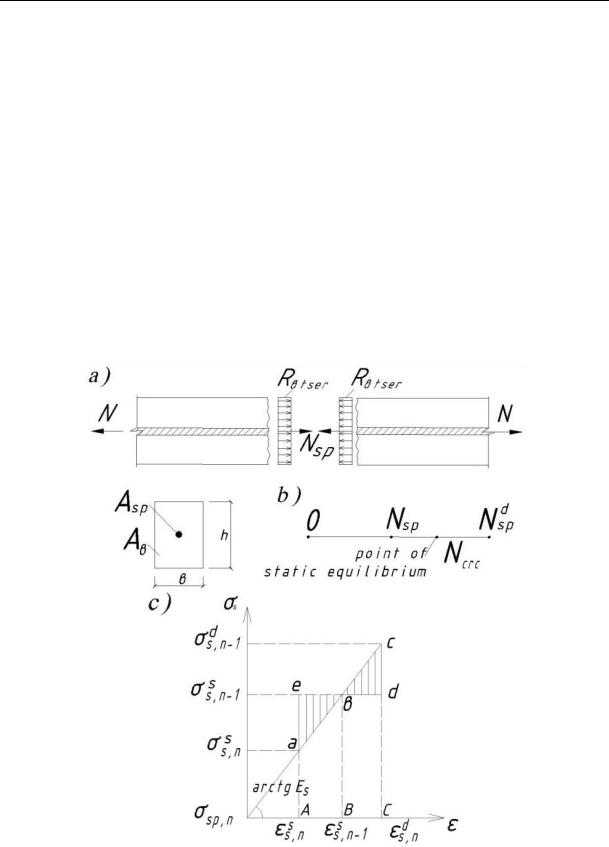
Учебное пособие 2092
.pdfSCIENTIFIC HERALD
OF THE VORONEZH STATE UNIVERSITY
OF ARCHITECTURE AND CIVIL ENGINEERING
CONSTRUCTION
AND ARCHITECTURE
1

The journal is indexed/abstracted in:
Web of Science Core Collection
(Emerging Sources Citation In-
dex)
(Thomson Reuters), USA
Ulrich's Periodicals Directory
(Bowker), USA,
DOAJ
(Lund University), Sweden,
Academic Search Complete
(EBSCO), USA,
SOCOLAR
(China Educational Publications
Import and Export Corporation ––
CEPIEC), China,
Google Scholar
(Google), USA,
E-Library
(ООО «РУНЭБ), Russia.
2
ISSN 2075-0811
SCIENTIFIC HERALD
OF THE VORONEZH STATE UNIVERSITY
OF ARCHITECTURE AND CIVIL ENGINEERING
CONSTRUCTION
AND ARCHITECTURE
N 4 (32)
BUILDING STRUCTURES, BUILDINGS AND CONSTRUCTIONS
BASES AND FOUNDATIONS, UNDERGROUND STRUCTURES
HEAT AND GAS SUPPLY, VENTILATION, AIR CONDITIONING, GAS SUPPLY AND ILLUMINATION
WATER SUPPLY, SEWERAGE, BUILDING CONSTRUCTION OF WATER RESOURCES PROTECTION
BUILDING MATERIALS AND PRODUCTS
TECHNOLOGY AND ORGANIZATION OF CONSTRUCTION
DESIGNING AND CONSTRUCTION OF ROADS, SUBWAYS, AIRFIELDS, BRIDGES AND TRANSPORT TUNNELS
BUILDING MECHANICS
ENVIRONMENTAL SAFETY OF CONSTRUCTION AND MUNICIPAL SERVICES
THEORY AND HISTORY OF ARCHITECTURE, RESTORATION AND RECONSTRUCTION OF HISTORICAL
AND ARCHITECTURAL HERITAGE
ARCHITECTURE OF BUILDINGS AND STRUCTURES. CREATIVE CONCEPTIONS OF ARCHITECTURAL ACTIVITY
CITY PLANNING, PLANNING OF VILLAGE SETTLEMENTS
FIRE AND INDUSTRIAL SAFETY (CIVIL ENGINEERING)
Voronezh 2016
3

SCIENTIFIC HERALD
OF THE VORONEZH STATE UNIVERSITY OF ARCHITECTURE AND CIVIL ENGINEERING
Construction and Architecture
Periodical scientific edition
Published since 2009 |
Comes out 4 times per annum |
Founder and publisher: Federal State Education Budget Institution of Higher Professional Education
«Voronezh State Technical University».
The articles are reviewed and processed with the program ANTIPLAGIARISM. This publication cannot be reprinted without the prior permission of the publisher, references are obligatory.
EDITORIAL COUNCIL
The Head of the Council: Kolodyazhny S.A., rector (Voronezh State Technical University)
EDITORIAL BOARD
Editor-in-Chief: Melkumov V. N., D. Sc. in Engineering, Prof.
(Voronezh State Technical University)
Members:
Gagarin V. G., Corresponding Member of RAABS, Moscow State University of Civil Engineering, Russia
Barsukov Ye. М., PhD in Architecture, Prof., Voronezh State Technical University, Russia
Boldyrev A. M., Corresponding Member of RAABS, Voronezh State Technical University, Russia
Bondarev B. А., D. Sc. in Engineering, Prof., Lipetsk State Technical University, Russia
Enin A. Ye., PhD in Architecture, Prof., Voronezh State Technical University, Russia
Esaulov G. V., Academician of RAABS, Moscow Architectural Institute, Russia
Golovinsky P.A., D. Sc. in Physics and Mathematics, Prof., Voronezh State Technical University, Russia
Karpenko N. I., Academician of RAABS, Research Institute of Building Physics (NIISF RAABS), Russia
Kobelev N. S., D. Sc. in Engineering, Prof., Southwest State University, Kursk, Russia
Kolchunov V. I., Academician of RAABS, Southwest State University, Kursk, Russia
Ledenyev V. I., D. Sc. in Engineering, Prof., Tambov State Technical University, Russia
Lyahovich L. S., Academician of RAABS, Tomsk State University of Architecture and Building, Russia
Mailyan L. R., D. Sc. in Engineering, Prof., Rostov State Building University, Russia
Mischenko V. Ya., D. Sc. in Engineering, Prof., Voronezh State Technical University (Dep. of the Editor-in-Chief)
Editor: Litvinova T. A.
Panibratov Yu. P., Academician of RAABS, Saint Petersburg State University of Architecture and Civil Engineering, Russia
Podolsky Vl. P., D. Sc. in Engineering, Prof., Voronezh State Technical University, Russia
Rudakov O. B., D. Sc. in Chemistry, Prof, Voronezh State Technical University, Russia (Dep. of the Editor-in-Chief)
Slavinskaya G.V., D. Sc. in Chemistry, Prof, Voronezh State Technical University, Russia
Suleymanov А. М., D. Sc. in Engineering, Prof., Kazan State University of Architecture and Engineering, Russia
Fyedorov V. S., Academician of RAABS, Moscow State University of Railway Engineering, Russia
Fedosov S. V., Academician of RAABS, Ivanovo State Polytechnic University, Russia
Chernyshov Ye. M., Academician of RAABS, Voronezh State Technical University, Russia
Shapiro D. M., D. Sc. in Engineering, Prof., Voronezh State Technical University, Russia
Asanowicz Alexander, Prof., Dr. of Sn., Technical University of Bialystok, Poland
Figovsky Oleg L., Prof., Dr. of Sn., Member of EAS, Israel Korsun V. I., D. Sc. in Engineering, Prof., The Donbas National Academy of Civil Engineering and Architecture, Ukraine Nguyen Van Thinh, Prof., Dr. of Sn., Hanoi University of Architecture, Vietnam
Translator: Litvinova O. A.
THE ADDRESS of EDITORIAL OFFICE: 84 20-letiya Oktyabrya str., Voronezh, 394006, Russian Federation
Tel./fax: (473)2-774-006; e-mail: vestnik_vgasu@mail.ru
Signed to print 31.10.2016. Format 60×84 1/8. Conventional printed sheets 9.1. Circulation 500 copies. Order 334.
Published in Printing Office of Voronezh State Technical University 84 20-letiya Oktyabrya str., Voronezh, 394006, Russian Federation
ISSN 2075-0811
© Voronezh State Technical
University, 2016
4
CONTENTS |
|
BUILDING STRUCTURES, BUILDINGS AND CONSTRUCTIONS ................................................... |
6 |
Kolhunov V. I., Androsova N. B. |
|
Calculation of Additional Dynamic Stresses in Rebars of Flexural Reinforced |
|
Concrete Structural Elements Caused by Fragile Failure of Tensed Concrete .......................... |
6 |
HEAT AND GAS SUPPLY, VENTILATION, AIR CONDITIONING, |
|
GAS SUPPLY AND ILLUMINATION ........................................................................................... |
17 |
Kuznetsov S. N. |
|
Organization of Effective Air Exchange in Industrial Premises .............................................. |
17 |
Kushchev L. A., Nikulin N. Yu., Feoktistov A. Yu., Yakovlev E. A. |
|
Intensification of Thermal Processes in a Shell-and-Tube heat exchanger ............................. |
25 |
Medvedevа O. N., Frolov V. O., Kolosov A. I. |
|
Theoretical Substantiation of Method of Delivery Liquefied Natural Gas .............................. |
34 |
DESIGNING AND CONSTRUCTION OF ROADS, SUBWAYS, AIRFIELDS, BRIDGES |
|
AND TRANSPORT TUNNELS ..................................................................................................... |
46 |
Kokodeeva N. Ye. |
|
Probabilistic Life Assessment of Non-rigid |
|
Pavements Reinforced with Geosynthetic Materials ............................................................... |
46 |
Samodurova T. V., Gladysheva O. V. |
|
Estimated Blizzards Parameters for Winter Road Maintenance .............................................. |
52 |
BUILDING MECHANICS ............................................................................................................ |
59 |
Shapiro D. M. |
|
Using Elastic Solutions for Elastic Plastic Problems ............................................................... |
59 |
CITY PLANNING, PLANNING OF VILLAGE SETTLEMENTS ..................................................... |
70 |
Ahamri Niloufar, Mahdavinejad Mohammadjavad, Forsat Mehran |
|
Interaction of Natural Landscape and Modern Heritage in Case of Veresk, Iran .................... |
70 |
INSTRUCTIONS TO AUTHORS ................................................................................................... |
92 |
5

Scientific Herald of the Voronezh State University of Architecture and Civil Engineering. Construction and Architecture
BUILDING STRUCTURES, BUILDINGS AND CONSTRUCTIONS
UDC 69.07
V. I. Kolhunov1, N. B. Androsova2
CALCULATION OF ADDITIONAL DYNAMIC STRESSES IN REBARS
OF FLEXURAL REINFORCED CONCRETE STRUCTURAL ELEMENTS CAUSED
BY FRAGILE FAILURE OF TENSED CONCRETE
Southwest State University
Russia, Kursk, tel.: +7 (4712) 50-48-20, e-mail: rector@swsu.ru
1D.Sc. in Engineering, Prof., Member of the Russian Academy of Architecture and Construction Science,
Head of the Dept. of Unique Buildings and Structures
Orel State University
Russia, Orel, tel.: +7 (4862) 751-318
2PhD in Engineering, Assoc. Prof. of the Dept. of Building Constructions and Materials
Statement of the problem. The additional dynamic stresses are the result of a fragile failure of tensioned concrete and the crack formation. The determination of the additional dynamic stresses is performed without involving dynamic methods on the basis of the energy method taking into account the total energy constancy in an element under load. In this case the method takes into account the hypothesis that in the first half-wave of oscillations of tensioned rebars the increment of the stresses reaches its maximum value. The analytical models of V. M. Bondarenko and Vl. I. Kolchunov have been used for the calculation of a reinforced concrete element under a load at the moment of crack formation. On this basis, the authors have obtained an analytical expression for the determination of the increment of additional dynamic stresses in a prestressed reinforced concrete element which can be used in the assessment of survivability of reinforced concrete structural systems under a beyond limit states.
Results. The paper presents the method of calculation of additional dynamic stresses in rebars of a reinforced concrete element under bending at the moment of a fragile failure of tensioned concrete during the crack formation. Conclusions. The paper concerns the calculation of additional dynamic stresses in rebars of reinforced concrete structures under bending at the moment of crack formation.
Keywords: structural safety, criterion of survivability, durability, extremal condition, additional dynamic forces.
Introduction
According to the current regulations in Russia and some European countries, the accidental limit state design considering the failure of one of the element in a structural system should be performed for prestressed reinforced concrete structural elements of buildings and structures of higher level of importance. The abrupt failure of an element in a structural system causes the
© Kolhunov V. I., Androsova N. B., 2016
6
Issue № 4(32), 2016 |
ISSN 2075-0811 |
additional dynamic stresses and, in case of reinforced concrete structures, cracks in the remained structural system. Moreover cracks also lead to additional stresses in rebars. Suchactions should be especially considered for prestressed reinforced concrete structures in which rebars have a high level of stresses yet before additional dynamic internal loading.
For the design of prestressed reinforced concrete structures the Russian regulations [1] and Eurocode [2] establish the values of prestressing σsp (σp,max) as fractions of characteristic strength of rebars. To enhance the effect of the prestressing the value σsp is usually taken as close to the upper limit of a characteristic strength value of reinforcing steel. In European countries the maximum stress applied to the tendon is determined as:
p,max min k1 f pk ; k2 f p0,1k , |
(1) |
where fpk is a characteristic tensile strength of prestressing steel; fp0,1k is a characteristic 0,1% proof-stress of prestressing steel; k1 = 0,8 and k2 = 0,9. The only limitation is the satisfaction of the conditions of crack resistance of concrete in tension. At the same time, for the structures of two-component materials, such as reinforced concrete, there is another important limitation which establishes the upper limit of the prestressing values. The condition is associated with a dynamic effect in a structural system of two-component materials and with the consequent redistribution of stresses at abrupt failure of a fragile component such as concrete in tension [3].
Literature review. In the last two or three decades, a number of studies has been performed concerning not only structural safety problems but also the problem of structural survivability. One of the first studies in the field of structural survivability of buildings and structures in Russia was the research performed in the 1990s by scientists from the Russian Academy of Architecture and Construction Sciences such as G. A. Geniev, [3, 4], V. I. Travush [5], V. M. Bondarenko, V. I. Kolchunov [6, 7], N. I. Karpenko [8], and others. The issues related to the additional dynamic stresses in the reinforcement of concrete elements at the sudden brittle failure of the concrete are still fragmented [9, 10].
The assessment of dynamic stresses increments in a prestressed reinforced concrete
element in tension. For a more visual representation of the physical model of the staticdynamic deformation of a two-component material, such as reinforced concrete element let us use a very simple model for calculating a the load Ncrc causing crack formation. The crack formation in reinforced concrete (two-component) element in tension, providing a brittle fracture of concrete, causes the additional dynamic internal forces in rebars (see Fig. 1). Before
7

Scientific Herald of the Voronezh State University of Architecture and Civil Engineering. Construction and Architecture
crack formation at load Ntot = λcrcN total static force Ntot (resultant of imposed load and bond stresses) in reinforced concrete element in tension is taken by concrete Ncb and rebars Ncs [9]:
N Ncrc Nb N s . |
(2) |
At load higher than load causing crack formation Ncrc = λcrcN concrete in tension fails immediately and tensile stresses of concrete transfer to rebars abruptly causing additional dynamic internal force increasing up to Ndsp from Nсsp [3, 9]. At the moment before crack formation in tension area there are tensile forces in concrete Nb = Rbt * Abt and in rebars NS. When
Nb > Rbt * Abt concrete in tension fails immediately and tensile stresses of concrete transfer to rebars abruptly causing additional dynamic internal force in rebars and longitudinal oscillation of rebars (see Fig. 1, b, c). The value of the additional dynamic internal force can be determined on the basis of the energy method using the diagram σS-εS [9].
Fig. 1. Diagram of the stress state of concrete and reinforcement of an element in tension (a), a diagram of the longitudinal internal force in rebars (b) and the diagram σS-εS for determining increments of dynamic
stresses in rebars at the moment of crack formation (c)
8
Issue № 4(32), 2016 |
ISSN 2075-0811 |
Since at the moment of the brittle fracture of concrete the tensile stresses of concrete transfer to rebars abruptly, the rebars are under longitudinal oscillation and internal dynamic force Nds can be calculated as follows:
N d N |
s |
2N |
b |
, |
(3) |
s |
|
|
|
Ns = Ns(P) + Nsp, Ns(P) is a tensile force in rebars caused by imposed load P, Nsp is a prestressing force.
Calculation model of static-dynamic deformation of a reinforced concrete element in
bending at the moment of the fragile failure of concrete. After the analysis of the staticdynamic deformation of axially tensioned two-component reinforced concrete element at fragile failure of concrete we move on to the analysis of reinforced concrete element in bending (see Fig. 2, a, b). The physical models of reinforced concrete proposed by V. I. Bondarenko and Vl. I. Kolchunov [11, 12] are taken as basic, and additional dynamic forces in rebars are proposed to be calculated on the basis of energy method. Using the constants of fracture mechanics and structural mechanics, the model proposed by V. I. Bondarenko and Vl. I. Kolchunov describes the stress-stain state of concrete at crack area more efficiently [13, 14].
The point of the method is that the analytical model includes two-console elements [11] that provide the connection between potential energy of deformed reinforced concrete element and compliance coefficient ξ of crack borders during crack formation and connection between the compliance coefficient and traditional parameters of concrete E, G, ε under deformation.
The two-console element helps take into account the connection between stress-strain state of concrete at prefracture zone and some constant ζbu depending on concrete parameters. Herewith, the compliance of crack borders, which may be used for the evaluation of ζbu value, can be defined by means of general methods of structural mechanics. Therefore, the two-console element is used as an connection link between relations of solid mechanics and fracture mechanics. The compliance of a two-component element used for crack modeling is connected with movements of a whole reinforced concrete element. Therefore, there is a methodological connection between calculations performed in ULS and SLS design (between first and second groups of limit states as adopted in the Russian regulations).
In general form the function of the compliance can be obtained from the determination of the potential energy release rate:
bu |
|
δW δV |
|
dW |
|
dV |
|
|
|
lim |
|
|
= |
|
|
, |
(4) |
||
|
dA |
dA |
|||||||
|
A 0 |
δA |
|
|
|
|
|||
9

Scientific Herald of the Voronezh State University of Architecture and Civil Engineering. Construction and Architecture
δV –– reduction of the potential energy of the body at crack extension increment δA; δW –– the additional work done on the body at crack extension increment δA; A –– area of the resulting surface of a crack.
On the basis of the considerations set out above, the two-console model can be presented as shown in the scheme in Fig. 2 c, d. The parameter tb (which stands for dimension of compressed concrete near a crack), according to Saint Venant principle and experimental study of a zone near rebars involving semi-analytical and analytical methods [13, 15], in first approximation can be taken as one and a half diameter of rebar. Further, the tb value is taken from refined solution of the problem of concrete-reinforcement bond. Tensile stresses in the regarding sections are assumed to be distributed according to a quadratic parabola from the neutral axis to the point where the stresses change sign. Herewith, the maximum values of tensile stresses is limited to Rbt value. Therefore, the sizeable area of cross-section in compression has the stress distribution close to the rectangular shape despite the distribution law at elastic stage. Tensile stresses in the cross-section near reinforcement have triangular distribution.
The paper [10, 16, 17] shows that generalized relation "load –– displacement" for the assumed two-console element is non-linear and load –– displacement curve can have a falling branch. The area of diagram used for potential energy determination differs from 0,5P0e0. P0 is generalized load and e0 is a generalized displacement. Integrals describing areas of such diagram give the values close to (2/3) P0e0, therefore the potential energy expression can be represented as follows:
V 23 P0 e0
The compliance C of the element in general can be determined as follows: e0 C P0 .
With regard to the assumed two-console element subjected to five load factors (
Mcon) we obtain the following equation:
|
1 |
5 |
P 2 C |
i |
|
P |
ζ bu = |
|
|
|
Ci Pi |
i . |
|
3 |
A |
|
||||
|
|
|
|
A |
||
|
|
i=1 |
|
|
|
|
The algebraic transformation leads to the following expression:
(5)
(6)
T, P1, P2, q,
(7)
ζ |
|
= |
1 |
( |
2 |
C |
I |
+ P2 |
C |
II |
+ P2 |
C |
II |
+ b2 P2 |
Cq |
+ M 2 |
C |
0 |
|
|
|
|
h |
|
h |
|
h |
|
h |
|
|
||||||||
|
bu |
|
3b |
|
|
|
1 |
|
2 |
|
bt |
con h |
|
|
|||||
|
|
|
|
|
|
crc |
|
crc |
|
crc |
|
crc |
|
crc |
|
||||
|
|
|
ΔT |
|
|
|
P |
|
|
P |
|
|
|
|
M |
con |
|
|
C |
I |
ΔT |
|
C |
II |
P |
1 |
C |
P |
2 |
C |
0 |
M |
con |
|
) , |
(8) |
|
h |
h |
h |
h |
|
||||||||||||||
|
|
|
1 |
|
III 2 |
|
|
|
|
|
||||||||
|
|
|
crc |
|
|
|
crc |
|
|
crc |
|
|
|
|
crc |
|
||
10
